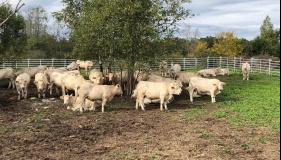
Our work
This action is a direct follow-up of action A.2 – nest site inventories – whose main outcome will be the information on the location of 500 LSE nests. According to the official regulations, the registered nest sites will require establishment of small protected areas – microreserves. Experts will evaluate information on the nest territory, prepare the documents necessary for microreserve proposals and submit them to the State Forest Service or Nature Conservation Agency.
Microreserves will be designated, using the latest knowledge on species ecology. Each nest will be surrounded by 5-30 ha large sanctuary where forestry activities will be significantly restricted, central part of microreserve will be supplemented by bufferzone with seasonal restrictions in force. An approach of “island microreserves” will be widely adapted.
The established network will complement the national network of Natura 2000 sites.
Expected results – 500 pairs of Lesser Spotted eagles breeding in nest sites that are protected from logging and disturbances. Until the end of 2020 we have submitted 457 microreserve proposals, 361 of them have been approved. The total territory of the approved microreserves amounts to 2620,2 ha.
Our work
Lesser spotted eagles is a forest breeding species that builds nests in trees. The most important nest tree species in Latvia is spruce, followed by the birch and aspen. Nests in the spruce trees are the most unstable – often built on side branches that are exposed to snow during winter. If nest has fallen, properly build artificial nest is often accepted by eagles. In Latvia there is a method developed for the building of articifial nests for white tailed eagle that has been sucessfully used for the protection of these species.
Action C.3 relies on information, gathered during Action A.2 and D.2. It is expected that around 10% of nests, being in the scope of the project will require stabilisation or providing new platforms. The necessary activities are done during the September-March – outside the breeding season.
Until the 2021 breeding season more than 30 artificial nests have been built. In 2020 season 12 of these nests were occupied by lesser spotted eagle, two were not occupied, but frequented by lesser spotted eagles, two were occupied by common buzzard.
Expected results until the end of the project: 50 nests of lesser spotted eagle stabilised or fully replaced by the artificial platforms.
The quality and availability of foraging grounds is among the most important factors that influence the breeding success of Lesser spotted eagle. Food of LSE contains rodents, frogs and moles that are available from open habitats – agricultural lands, semi-natural grasslands and set-asides. Therefore the economic activity on agricultural lands plays an important role in breeding success of LSE.
During the last century, large areas of former agricultural lands have naturally afforested. This is the case also in Nature park “Kuja"’. There are abandoned grasslands that can still be restored. The project restoration works are carried out in 30 ha of grasslands.
We are restoring the following EU habitats:
- 6450 Floodplain grasslands;
- 6530* Wooded meadows;
- 6410 Molinia meadows
Progress in spring 2021:
- Bushes have been cut and removed in 30 ha and five different land units (4 private owners, 1 state forrest territory)
- Preparation works for stomp removal are ongoing and will be completed in august 2021.
The restoration is done in cooperation with the local land owners who will continue the work after the end of project implementation.
LSE feeding habitats in Nature reserve “Lubāna mitrājs” area “Grīvu sala” are restored by making 260 ha of grasslands available for grazing operation. This included removal of bushes and trees from approximately 15 ha of Northern boreal alluvial meadows (6450) and from approximately 30 ha of Fennoscandinavian wooded meadows (6530*). Also drainage diches in length of approximately 30 km were be closed in order to restore the natural hydrological regime.
This activity solved the key problems of this territory – the changed hydrological regime, overgrowns grasslands and it would now become a habitat that is suitable for lesser spotted eagle. This case will also serve as a best practice example for similar territories.
LFN is responsible for grassland restoration and SIA “Tīravoti” is responsible for the actual restoration work.
Establishment of grazing operation in Nature reserve “Lubāna mitrājs” area “Grīvu sala” on 260 ha of grasslands by purchase of 80 pregnant beef heifers will result in restored area that provides excellent feeding grounds for up to 5 pairs of LSE. Freshly mown as well as grazed grasslands are excellent feeding grounds, where LSE hunt for small rodents and moles and flooded meadows with low water table serve as good source of frogs.
This action will continue at the end of the project and the project will deliver an intensive pulse of activity, above and beyond the normal level of mowing and grazing allowing the action to be significantly reduced post project.
In 2021 the fourth grazing season in Grīvu sala started.
SIA “Tīravoti” is responsible for establishment and operation of the grazing operation. Grasslands restoration coordinator of LFN will overview the grazing operation ensuring the best results for biodiversity.



